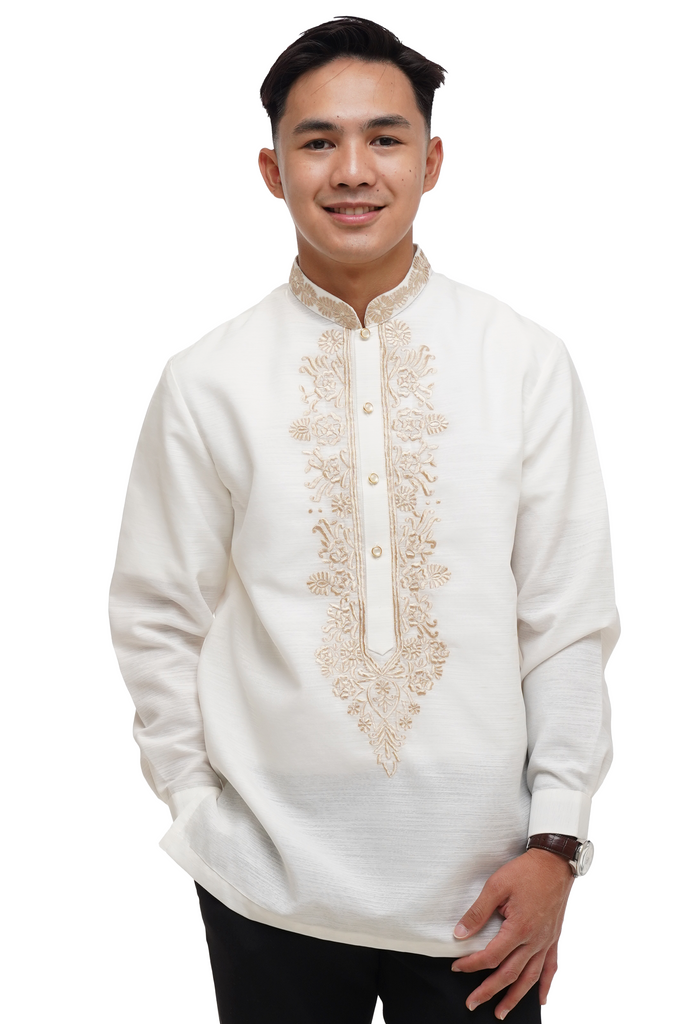How Formal Barong Tagalog can Save You Time, Stress, and Money.
Table of ContentsThe Barong Tagalog Jacket DiariesFacts About Barong Tagalog UncoveredA Biased View of Barong Tagalog Shirt

It is a common official or semi-formal clothes in Filipino society, and is used untucked over an underwear with belted trousers as well as gown shoes. Baro't saya is the womanly matching of barong tagalog, with the Maria Clara dress being the formal variation of the last. Barong tagalog was additionally referred to as ("external tee shirt") in Philippine Spanish. filipino barong tagalog. The term is normally not capitalized.
Instead, the name was created to distinguish the outfit as indigenous (thus "tagalog", i. e. ), as opposed to the designs of gown of Europeans and also other international societies. Summary [modify] Barong tagalog worn with a salakot. The woman is putting on a. Barong tagalog is a formal t shirt typically made of sheer lightweight but tight fabric called (generally woven from pia or abac fibers).
The term camisa de chino is likewise used for collar-less as well as cuff-less t shirts, called after its resemblance to tee shirts put on by Chinese laborers. It is put on with belted trousers and outfit shoes. Headgear, when used, is either a salakot or a buntal hat (and traditionally additionally leading hats or bowler hats). Barong tagalog can differ considerably in regards to style and also material made use of, but they share usual characteristics of having long sleeves, needlework, being buttoned (midway or straight down the breast), as well as the lack of pockets. They are likewise worn loosely and have slits on both sides. Historically, the material used for barong tagalog depended upon the social course of the user and the formality of the event.
What Does Formal Barong Tagalog Mean?

The top quality of the product and also the complexity of the embroidery were usually indicators of the standing as well as riches of the wearer. The embroidery of the barong tagalog are generally put on a rectangle-shaped area on the front of the breast (referred to as pechera, "shirt front", from Spanish pecho, "upper body"), and/or over the entire t shirt (sabog, from Tagalog for "spread"). official statement.
History [edit] Pre-colonial age [edit] The barong tagalog stemmed from the Tagalog baro (essentially "t shirt" or "clothing", likewise called bar or bay in other Philippine languages), an easy collar-less tee shirt or coat with close-fitting long sleeves used by both guys and ladies in the majority of ethnic teams in the pre-colonial Philippines. These were made from rough linen-like fabric woven from native abac fiber, or from imported textiles woven from silk, cotton, and also kapok, among others. Amongst Tagalog guys, they were typically coupled with a rectangular shape of highly enhanced fabric known as the salaual or salawal used knee-length as well as created in the center (like an Indian or Thai and Cambodian ); while in women they were coupled with a wraparound skirt called the.
However, in the Visayas, besides similar baro (which had shorter sleeves) and also salaual mixes, guys likewise put on vibrant robe-like and also coat-like versions that could encompass well below the knees (recognized as the marlota as well as baquero in Spanish, respectively). These were occasionally belted at the waist. Amongst Tagalogs, red dyes and gold trimmings were indicative of being a member of the aristocracy () or the warrior caste () - i thought about this.

The Only Guide to Polo Barongs
The couturier Jose "Pitoy" Moreno has actually hypothesized that this transitional design of t-shirt was the camisa de chino of later centuries, that makes it a precursor to the barong tagalog. Depictions of members of the top classes (including citizens as well as) in the 18th century showed that they invariably wore European-style clothes. important site.
These were a lot longer than the modern barong tagalog, getting to down to a little above the knees. They were additionally typically striped with bold shades like blue, red, or environment-friendly. Nonetheless, they currently displayed trademarks of the modern barong tagalog, consisting of being made of large nipis material, needlework, long sleeves, and a loose silhouette with slits on both sides - click for more info.
Early examples of barong mahaba usually had high-standing collars or even Elizabethan-style ruffs with slim cravats. Barong mahaba were typically put on with vivid straight-cut pants with stripes, checkers, or plaid-like patterns (generally made from imported cambaya, rayadillo, as well as guingn textiles), stovepipe hats (sombrero de copa), as well as a kind of stitched velvet or natural leather slip-on footwear recognized as corchos. The large material utilized by barong mahaba likewise demanded the wearing of an underwear, called camisn or camiseta, which was additionally used on its very own by commoners. By the 1840s, barong mahaba mainly befalled of fashion. In this period, it progressed into the modern-day "traditional" barong tagalog, being much shorter with less extravagant folded up collars, while still maintaining the large fabric and other baro attributes.